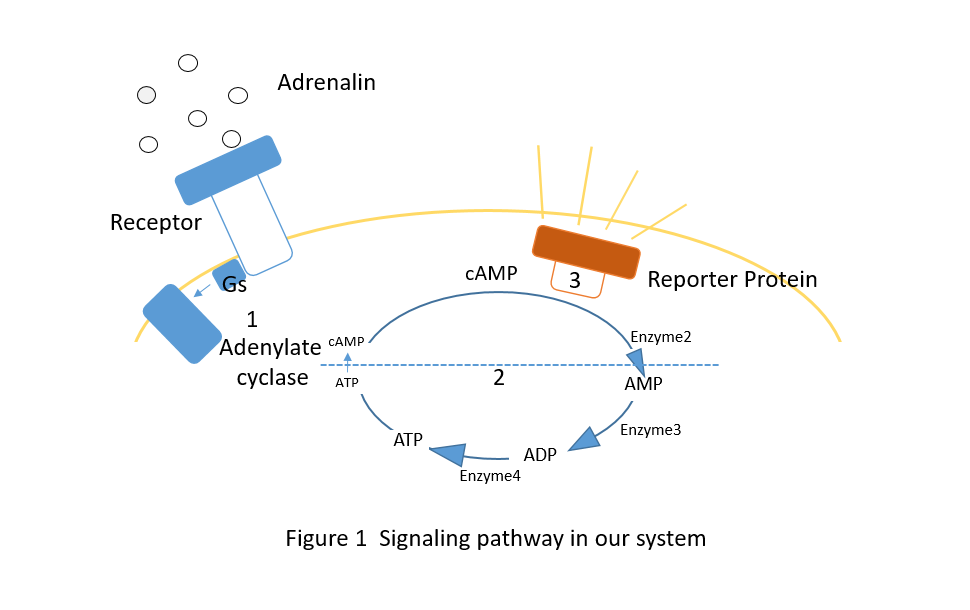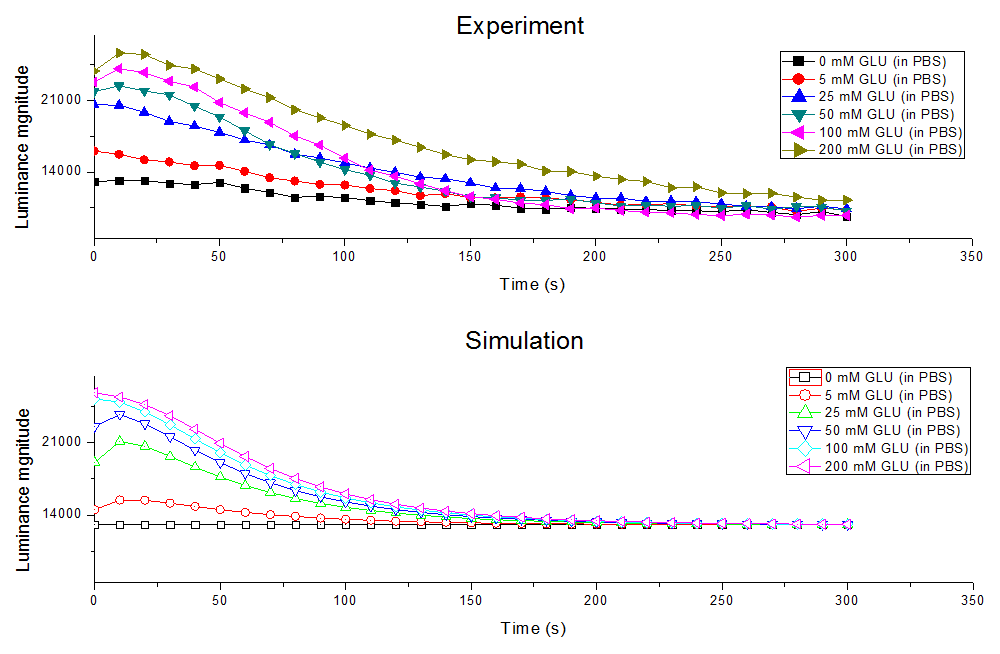Yeast luminescence process
Description
In this section, we established a model for the quantity relationship between the concentration of adrenalin and the luminance magnitude of yeasts which includes the physiological process as receptor signaling, cAMP-AMP-ADP-ATP-cAMP circulation and reporter protein lightening. After the parameters in the model were adjusted, we found that our simulation results fits experiment results well.
Basic assumption
- The Adrenalin is uniformly distributed amid yeasts
- The number of yeasts during lightening period is constant and the physical state of each yeasts is the same
- The function of the receptor, Gs protein, Adenylate cyclase and reporter protein is not saturated
- During the whole process, the total concentration of cAMP,AMP,ADP,ATP in the cell and the concentration of adrenalin are constant and in the beginning the concentration of cAMP is half of the total concentration of cAMP,AMP,ADP,ATP
- Without stimulation, we assume the concentration of cAMP in cells stay constant
- To simpify the problem,we see the process of the conversion of AMP-ADP-ATP as a whole,which we define Process I.
Variables
- N: the total concentration of cAMP,AMP,ADP,ATP
- NcAMP: the concentration of cPMP
- NA:the concentration of Adrenalin
- L:luminance magnitude
Formula and derivation

As shown in figure1, the signal pathway of Adrenalin-influenced yeasts’ lightening can be divided into three parts:
- Receptor signaling: Our receptor is specific to Adrenalin. When the receptor on the cell membrane combine with Adrenalin,Adenylate cyclase downstram will be activated and translate ATP to cAMP.
- cAMP-AMP-ADP-ATP-cAMP circulation:to simplify the problem, we see the transformation from AMP to ATP as a whole
- Reporter protein lightening: Our receptor protein is only activated by cAMP.
After analyzing the signal pathway of Adrenalin-influenced yeasts’ lightening, it can be instinctively noticed that the variation of the concentration of cAMP is critical in the problem.
Receptor signaling
- Based on assumption 3 and the effect of the receptor, we can know that the rate of the formation of cAMP is positively related to the concentration of Adrenalin.
- Besides, since cAMP is formed after Process I, we can know that the rate of the formation of cAMP is also positively related to the total concentration of AMP, ADP and ATP in cells.
- In reality, the working efficiency of our receptor will decrease during the period of detection. We assume the relationship of its working efficiency corresponding to time as E(t)=e-t.
Therefore, we can get the situation of the formation of cAMP in receptor signaling as:

cAMP-AMP-ADP-ATP-cAMP circulation
Apart from the formation of cAMP mentioned in the Receptor signaling, there are many other physiological process in cells which can also form cAMP. We see them as a whole and the rate of it is simply positively related to total concentration of AMP, ADP and ATP in cells.
In the cAMP-AMP-ADP-ATP-cAMP circulation, there are many physiological process in cells which can transform cAMP to AMP and the rate of it is positively related to the concentration of cAMP in cells.
Therefore, we can get the situation of the formation of cAMP in the circulation as:

Based on equation (1) and (2), we can derive the formulation of the concentration of the cAMP in cells corresponding to the concentration of the Adrenalin as:

If NA=0, then the concentration of cAMP should be constant, that is:

Then we can get:

Since in the beginning the concentration of cAMP is half of all, we can get:

Reporter protein lightening
As the mechanism of our reporter protein [2] indicates, we assume that the luminance magnitude is proportional to the concentration of cAMP in the cell, therefore we can get our final formula:

Simulation and results
We also use the Levenberg-Marguard nonlinear optimization algorithm in this model as numerical simulation and get results below. We can see that the figure shows that our simulation is almost the real situation and the f is really small, which means that our model is pretty reliable. The table showed below is the simplified parameters got in our model. The form of which the parameters correspond to the formula showed above is also shown in the table.


Reference
[1] Kholodenko, B. N., Demin, O. V., Moehren, G. & Hoek, J. B. Quantification of short term signaling by the epidermal growth factor receptor. J. Biol. Chem.274, 30169–30181 (1999).
[2]Saito K, Chang Y F, Horikawa K, et al. Luminescent proteins for high-speed single-cell and whole-body imaging[J]. Nature communications, 2012, 3: 1262.




